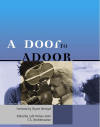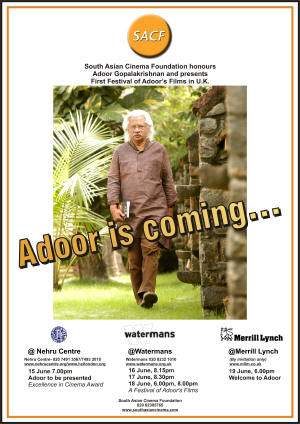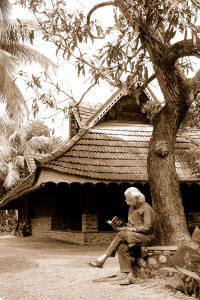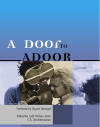|
|
SouthAsianCinema |
|
|
|
|
► Home ► About Us ► SACF ► Events ► Reviews ► Legends ► Feedback THE BOOK A DOOR to ADOOR
For excerpts from
You will need an
|
Image, Imagination and Creativity By Adoor Gopalakrishnan
It may be the nth time you are being asked this question, but it puts you ill at ease every time. Sensing the sincerity and the earnestness of the person who asks the question, you start addressing it yourself and realise that it is not an easy query that can be answered off-hand. It takes a few moments before you start answering – rather muttering diffidently, ‘well – you see – what I wish to say is that…‘etc. An innocent question – all the same a relevant one, it has in a strange way disturbed you. You have to find an answer quickly and make it intelligible to the person standing before you in all expectation and curiosity How do I get ideas? In other words, where do I get the inspiration, how do I create my work? The question is about the secret of creativity. A quick, simple, safe and honest answer would be, ‘Excuse me, I do not know’. But you do not admit it that easily, because you consider yourself an artist and an intellectual by inference. So, the onus of answering the simple and direct question is squarely on you and it keeps staring at you. ‘Well—it happens’, you whimper. Your nemesis is least pleased. In the mean time you start searching within yourself. The answer, rather the conjectures start stuttering in… The ideas come from life- what you have been living through… all that you have observed – from other sources – literature, arts, history, teachers, elders, parents, peers, relations, friends, foes, rivals – the society at large. ‘All right, but the sources and circumstances being the same, how come everyone does not get these ideas?’ ‘Well, some are more sensitive and impressionable than the others. You can’t rationalise and explain it. Creativity defies simple definitions and explanations.’ You think you have answered, but not really. The question remains and you need to do your own search. The search in itself is well worth undertaking. It is common knowledge that a person without the faculty of memory, is incapable of imagination and creativity. Memory, per se is linked with experience. It is stored in images and recreated as imagery. And imagination is the act of creating new images or ideas by combining previous experiences. Imagination is often regarded as the more seriously and deeply creative faculty, which perceives the basic resemblances between things, as distinguished from fancy – the lighter and more decorative faculty, which just takes in superficial resemblances.
Experience is anything observed or lived
through. It has many shades and grades. The most important is the
individual reaction to things and events where one is directly involved. At another level, experience is borrowed through empathy. You make the other person’s experience your own in order to understand him and his predicament. A different shade of experience is the one that comes from the appreciation of arts, literature, theatre, cinema etc. The more genuine and artistically integrated they are, the better is the impact they leave on one’s mind. Slowly, but surely this experience also gets processed and assimilated as valuable observation of life one can draw upon. Life that is closely observed and deeply felt, and portrayed here is unique and is devoid of the non-essentials. Then, there is also the case of information as experience. Print and electronic media do provide daily information of life lived around us and elsewhere and it surely becomes part of our experience, no matter how peripheral it is. What cannot be dismissed as superstition is the element of knowledge and experience one is born with. It comes by genetic inheritance. Images, the indivisible units of memory, have a life of their own. They grow and shrink. They glow and perish. They are organic. They are like their perceiver – the artist, the writer – the one who creates the imageries. Imageries, after all, are not real replicas of the image. Something, some chemical process, some transformations take place between the conception of the image and the time of its recapture and recreation. One element that counts in this context, is time. But then it is not time alone. Along with passage of time, one’s ever expanding perceptions of life have a vital role to play. I was born in a remote village in Kerala – far from the roadways, away from the waterways. Access to the farm lands, particularly paddy fields, was the prime consideration for the family to locate itself there (This I realized much later in life as I came into contact with a world outside my village). Remaining part …………….. read in the Book "A Door to Adoor" (For excerpts form the book, please click the picture above)
|


 ‘Where
do you get your ideas? ‘I am often asked. The question does not come from
critics because they already know about everything and they have no
doubts. It does not come from the so-called intellectuals either because
it is not befitting their status to ask such elementary questions. The
source of the question invariably is a simple person who is not important
enough to be in possession of answers to every question concerning men and
matters of life.
‘Where
do you get your ideas? ‘I am often asked. The question does not come from
critics because they already know about everything and they have no
doubts. It does not come from the so-called intellectuals either because
it is not befitting their status to ask such elementary questions. The
source of the question invariably is a simple person who is not important
enough to be in possession of answers to every question concerning men and
matters of life. 
